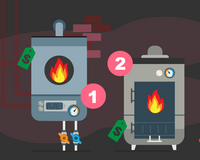On the surface, mobile home furnace parts and features may seem identical to their conventional counterparts that operate in traditional homes; however, looks can be deceiving.
This is due to the fact that mobile home furnaces and the systems that support them are designed to specifically counter the challenges that come with trying to heat a mobile home. One of the most evident differences is the fact that mobile home furnaces utilize a sealed combustion venting system. This type of system is built to accommodate the smaller space constraints of a mobile home – which in turn means smaller heating ducts and vents. This sealed combustion venting system is safer for mobile homes when compared to regular furnaces. In fact, putting a regular furnace in a mobile home is considered to be a fire hazard because the overall heat output of these furnaces can be too much for the small ducts and vents.
Now, let’s take a closer look at the anatomy of a furnace, as well as how the parts and features differ based on how they produce heat.
Popular Mobile Home Gas Furnace
As their name would suggest, gas furnaces produce heat through the combustion of natural gas. In the past, natural gas furnaces were noticeably overshadowed by the more widespread oil furnaces but in recent years this has changed dramatically. In fact, nowadays, it could be argued that natural gas furnaces are the most popular type of furnace for mobile homes.
Given that gas furnaces need to be able to convert natural gas to heat, this type of furnace notably features a pilot light. The purpose of this pilot light is to ignite the burners that are inside the furnace’s combustion chamber. This in turn sends heat into the furnace’s heat exchanger and then from there the blowers drive the heat through the connected ducts and into the air of your mobile home.
Traditional Mobile Home Oil Furnace
For mobile homes, as well as other types of residences and structures, oil furnaces are often viewed as being the more traditional choice. However, traditional does not always equate to better and like all other types of furnaces, oil furnaces for mobile homes come with their own set of pros and cons – which should be considered before purchasing.
Oil furnaces are similar in configuration to the aforementioned natural gas furnaces but there are also some very notable differences. The oil that serves as the furnace’s fuel is sprayed, at high pressure, into the combustion chamber where it is then ignited. As the oil mist burns, it creates heat that is then sent through the connected ducts. The heat then exits through vents and is circulated throughout your mobile home. Oil furnaces are most commonly used in conjunction with floor vents but they can also be connected to other types of vents if need be.
Electric Furnaces for Mobile Homes — a More Modern Option
Is an electric furnace a viable choice for your mobile home? Well, from stoves to cars, electric alternatives to more conventional means of powering machines have become more and more popular in recent history. Can the same be said for electric furnaces?
While the anatomy of a natural gas furnace and an oil furnace is relatively similar, the mechanical components of an electric furnace are strikingly different. The biggest difference is that an electric furnace does not have a combustion chamber. This is because an electric furnace does not use combustion to produce heat. Instead, an electric furnace pulls in cold air, where the internal electric components then heat it up. After the air is pushed through the heat exchanger, it is then circulated through your mobile home by being sent through the ducts and out the vents.
Pros and Cons – Comparing The Different Mobile Home Furnace Parts and Features
Heating Components
The heating components are the most important parts of a mobile home furnace and each of the three aforementioned types is different in this regard.
- Natural gas furnaces for mobile homes operate by converting gas into heat. A pilot light inside your natural gas furnace ignites burners that are inside the combustion chamber.
- Oil furnaces for mobile homes operate by burning oil to generate heat. The oil is sprayed as a mist into the combustion chamber, where it is then ignited and burned.
- Electric furnaces for mobile homes operate by drawing in cold air and heating it. As your electric furnace pulls in cold air, its internal electrical components heat up and hot air is then pushed outwards.
Price
The prices of mobile home furnaces and mobile home furnace parts can vary greatly depending on manufacturers, materials, retailers, and models. However, the market does have some distinct trends that can be observed.
- Oil furnaces for mobile homes will usually have a larger upfront cost compared to natural gas furnaces and electric furnaces for mobile homes. Oil furnaces for mobile homes have prices that start from $1,500; however, a lot of high-quality models can easily go for more than $2,000.
- Natural gas furnaces for mobile homes can generally be found at mid-range prices, especially when they are compared to electric furnaces and gas furnaces for mobile homes. More efficient natural gas furnaces for mobile homes will generally have higher selling prices, starting from around $1,100. On the other hand, less efficient natural gas furnaces for mobile homes can sell for prices as low as $850.
- Electric furnaces for mobile homes are, on average, the most cost-effective choice when it comes to upfront cost. It is not uncommon to see electric furnaces for mobile homes with prices under $1,000 and the cheapest models can sell for as low as $600.
Efficiency
Mobile home furnace parts and models will noticeably affect their overall efficiency. However, that being said, each type of mobile home furnace does still have a very distinct efficiency range that is dependent on the way that they produce heat.
- Electric furnaces for mobile homes are incredibly efficient when it comes to their operation and heat production. Generally speaking, you can expect to see your mobile home electric furnace operating at coles to 100% efficiency.
- Oil furnaces for mobile homes have, on average, the lowest efficiency of the three types of mobile home furnaces. The average mobile home oil furnaces have an efficiency rating of about 80%. That being said, higher-quality oil furnace models can have slightly higher efficiency ratings.
- Natural gas furnaces for mobile homes fall squarely in the middle when it comes to efficiency; however, they also have the largest variation based on quality. All things considered, cheaper natural gas furnaces have an efficiency rating of approximately 80%. On the other hand, more expensive and higher-quality mobile home gas furnaces can have an efficiency rating of up to 95%.
Operating Cost
Operating costs are an important factor of mobile home furnaces that should always be considered. However, first-time buyers often overlook this aspect and instead focus solely on the initial, upfront cost of their mobile home furnace. Here’s how the operating costs of the different types of mobile home furnaces vary.
- Oil furnaces for mobile homes are extremely cost-effective in the long run, which helps to offset their high upfront cost. That being said, owners of mobile homes should keep in mind that they will have to buy (and have reserves of) oil regularly to keep their oil furnace operational.
- Natural gas furnaces for mobile homes are fairly cost-effective in the long run, which definitely complements their mid-range upfront prices. In fact, it can be argued that some high-quality natural gas furnaces are just as cost-effective as similar oil furnaces for mobile homes.
- Electric furnaces are the oddball of the group because they have the potential to be the least cost-effective option, especially in colder climates. Mobile homeowners will have to decide for themselves if this operating cost is a worthwhile sacrifice to make for the convenience and efficiency that electric furnaces provide.
Other Pros and Cons of Each Type of Mobile Home Furnace
Here are some additional pros and cons of each type of mobile home furnace, which helps to set them apart from each other.
- Oil furnaces for mobile homes are extremely durable and long-lasting, especially when they are compared to electric and gas furnaces. That being said, oil furnaces are also more costly to repair whenever they are damaged or have parts that need to be replaced.
- Although electric furnaces for mobile homes do (potentially) have high operating costs, this is usually offset by certain benefits. For example, electric furnaces don’t need to be constantly refueled, they are efficient, and they are extremely convenient. In addition to this, electric furnaces for mobile homes are also relatively easy to repair, especially compared to oil furnaces.
- Natural gas furnaces for mobile homes are fairly durable and long-lasting, while also being somewhat easy to repair as well. In this regard, they fall somewhere in the middle between oil furnaces and electric furnaces. That being said, natural gas furnaces are also far quieter than other types of furnaces as well.
Total Furnace Replacement from Star Mobile
If there’s any part of your mobile home furnace broken, Star Mobile has the part to replace it. We offer a wide array of replacement parts from some of the most trusted names in the industry. Furthermore, if you’re in the market for a brand new furnace for your mobile home, we’ve also got you covered.






